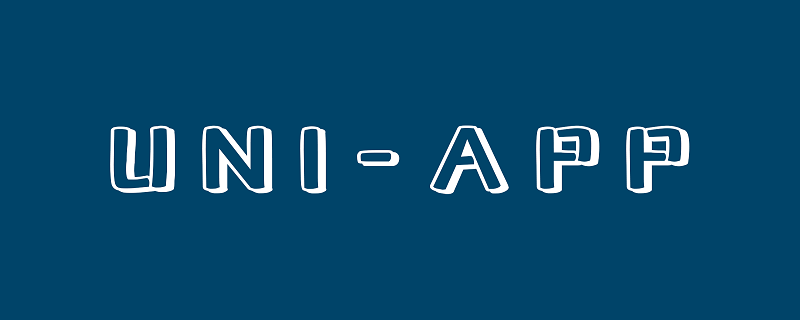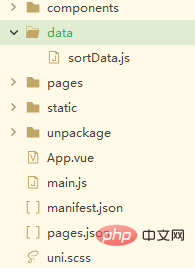How to load json file in uni-app
How to load json files in uni-app: 1. Create a new folder and put the data into js; 2. Pass "import sortdata from '../../data/sortData.js'. .." method to introduce the json file into the uni-app page.

The operating environment of this article: windows7 system, uni-app version 2.5.1, DELL G3 computer.
How does uni-app load json files?
uni-app imports local json data into the page and uses
1. In the project root folder, first create a new folder and then throw the data into js

2, js
let data = {
//这里放数据
}
module.exports = {
data: data
}3, uni-app page introduction
<script>
import sortdata from '../../data/sortData.js'
export default {
data() {
return {
list: sortdata
}
}
}
</script>Recommended: "uniapp tutorial"
The above is the detailed content of How to load json file in uni-app. For more information, please follow other related articles on the PHP Chinese website!

Hot AI Tools

Undresser.AI Undress
AI-powered app for creating realistic nude photos

AI Clothes Remover
Online AI tool for removing clothes from photos.

Undress AI Tool
Undress images for free

Clothoff.io
AI clothes remover

Video Face Swap
Swap faces in any video effortlessly with our completely free AI face swap tool!

Hot Article

Hot Tools

Notepad++7.3.1
Easy-to-use and free code editor

SublimeText3 Chinese version
Chinese version, very easy to use

Zend Studio 13.0.1
Powerful PHP integrated development environment

Dreamweaver CS6
Visual web development tools

SublimeText3 Mac version
God-level code editing software (SublimeText3)

Hot Topics
 1393
1393
 52
52
 1207
1207
 24
24
 How to exclude a field from JSON using @Expose annotation in Java?
Sep 16, 2023 pm 09:49 PM
How to exclude a field from JSON using @Expose annotation in Java?
Sep 16, 2023 pm 09:49 PM
The Gson@Expose annotation can be used to mark whether a field is exposed (contained or not) for serialization or deserialization. The @Expose annotation can take two parameters, each parameter is a boolean value and can take the value true or false. In order for GSON to react to the @Expose annotation, we have to create a Gson instance using the GsonBuilder class and need to call the excludeFieldsWithoutExposeAnnotation() method, which configures Gson to exclude all fields without Expose annotation from serialization or deserialization. Syntax publicGsonBuilderexclud
 Combination of golang WebSocket and JSON: realizing data transmission and parsing
Dec 17, 2023 pm 03:06 PM
Combination of golang WebSocket and JSON: realizing data transmission and parsing
Dec 17, 2023 pm 03:06 PM
The combination of golangWebSocket and JSON: realizing data transmission and parsing In modern Web development, real-time data transmission is becoming more and more important. WebSocket is a protocol used to achieve two-way communication. Unlike the traditional HTTP request-response model, WebSocket allows the server to actively push data to the client. JSON (JavaScriptObjectNotation) is a lightweight format for data exchange that is concise and easy to read.
 What is the difference between MySQL5.7 and MySQL8.0?
Feb 19, 2024 am 11:21 AM
What is the difference between MySQL5.7 and MySQL8.0?
Feb 19, 2024 am 11:21 AM
MySQL5.7 and MySQL8.0 are two different MySQL database versions. There are some main differences between them: Performance improvements: MySQL8.0 has some performance improvements compared to MySQL5.7. These include better query optimizers, more efficient query execution plan generation, better indexing algorithms and parallel queries, etc. These improvements can improve query performance and overall system performance. JSON support: MySQL 8.0 introduces native support for JSON data type, including storage, query and indexing of JSON data. This makes processing and manipulating JSON data in MySQL more convenient and efficient. Transaction features: MySQL8.0 introduces some new transaction features, such as atomic
 Performance optimization tips for converting PHP arrays to JSON
May 04, 2024 pm 06:15 PM
Performance optimization tips for converting PHP arrays to JSON
May 04, 2024 pm 06:15 PM
Performance optimization methods for converting PHP arrays to JSON include: using JSON extensions and the json_encode() function; adding the JSON_UNESCAPED_UNICODE option to avoid character escaping; using buffers to improve loop encoding performance; caching JSON encoding results; and considering using a third-party JSON encoding library.
 How to handle XML and JSON data formats in C# development
Oct 09, 2023 pm 06:15 PM
How to handle XML and JSON data formats in C# development
Oct 09, 2023 pm 06:15 PM
How to handle XML and JSON data formats in C# development requires specific code examples. In modern software development, XML and JSON are two widely used data formats. XML (Extensible Markup Language) is a markup language used to store and transmit data, while JSON (JavaScript Object Notation) is a lightweight data exchange format. In C# development, we often need to process and operate XML and JSON data. This article will focus on how to use C# to process these two data formats, and attach
 Use the json.MarshalIndent function in golang to convert the structure into a formatted JSON string
Nov 18, 2023 pm 01:59 PM
Use the json.MarshalIndent function in golang to convert the structure into a formatted JSON string
Nov 18, 2023 pm 01:59 PM
Use the json.MarshalIndent function in golang to convert the structure into a formatted JSON string. When writing programs in Golang, we often need to convert the structure into a JSON string. In this process, the json.MarshalIndent function can help us. Implement formatted output. Below we will explain in detail how to use this function and provide specific code examples. First, let's create a structure containing some data. The following is an indication
 Pandas usage tutorial: Quick start for reading JSON files
Jan 13, 2024 am 10:15 AM
Pandas usage tutorial: Quick start for reading JSON files
Jan 13, 2024 am 10:15 AM
Quick Start: Pandas method of reading JSON files, specific code examples are required Introduction: In the field of data analysis and data science, Pandas is one of the important Python libraries. It provides rich functions and flexible data structures, and can easily process and analyze various data. In practical applications, we often encounter situations where we need to read JSON files. This article will introduce how to use Pandas to read JSON files, and attach specific code examples. 1. Installation of Pandas
 How do annotations in the Jackson library control JSON serialization and deserialization?
May 06, 2024 pm 10:09 PM
How do annotations in the Jackson library control JSON serialization and deserialization?
May 06, 2024 pm 10:09 PM
Annotations in the Jackson library control JSON serialization and deserialization: Serialization: @JsonIgnore: Ignore the property @JsonProperty: Specify the name @JsonGetter: Use the get method @JsonSetter: Use the set method Deserialization: @JsonIgnoreProperties: Ignore the property @ JsonProperty: Specify name @JsonCreator: Use constructor @JsonDeserialize: Custom logic




